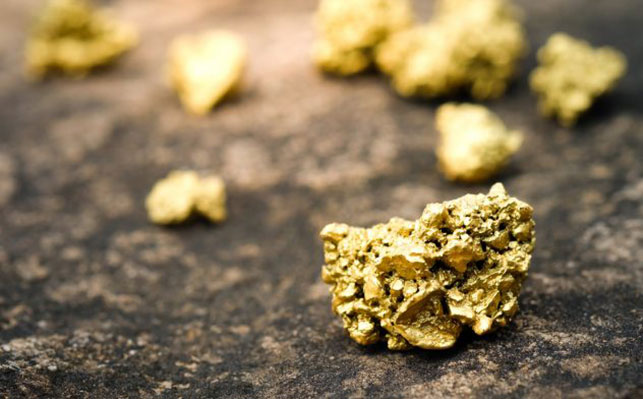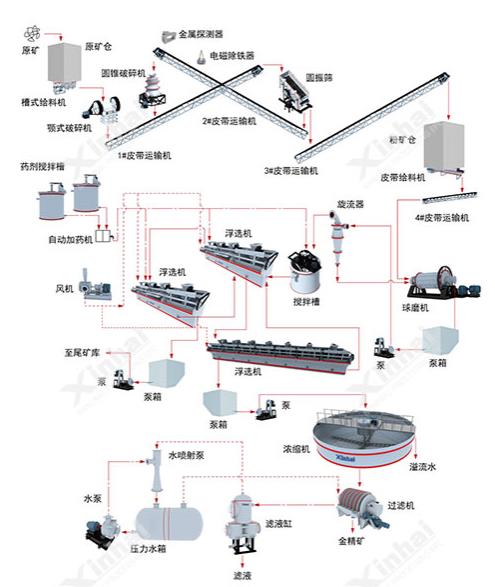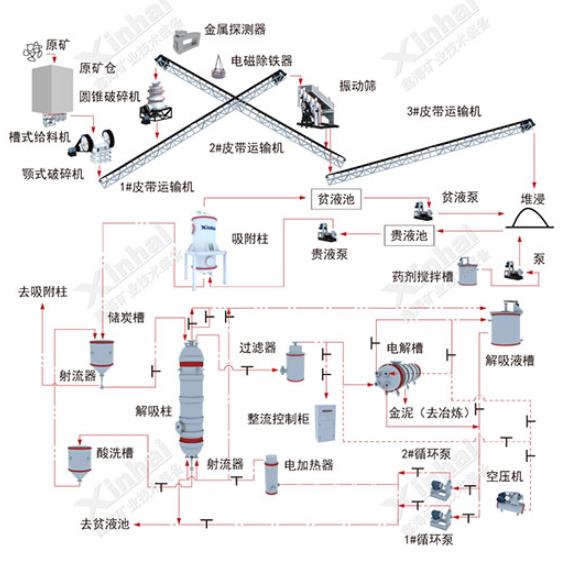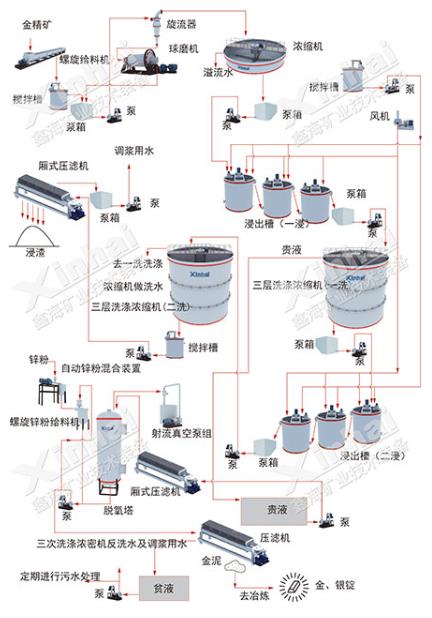
15311826613
Click to add WeChatAs gold is a hard currency, with the recent surge in gold prices, not only gold jewelry has received much attention, but gold mining has also received much attention, and more investors have begun to turn to the production and development of gold mines. At present, common gold ore dressing processes include: flotation, heap leaching, cyanidation, gravity separation and other methods. Below we will introduce these gold ore dressing process processes, and attach a gold mine process diagram!

Usually, any ore must be crushed, screened, ground and graded before flotation, and then dehydrated after flotation. This is the gold ore flotation process process.

Crushing and screening: According to the flotation particle size requirements of gold ore, the general crushing stage can adopt a one-stage closed-circuit crushing process or a two-stage closed-circuit crushing process. The raw ore is fed into the storage bin by the cloud mine car and sent to the crusher by the feeder to complete the crushing. The jaw crusher is generally used for coarse or medium crushing, and the hammer crusher is used for medium and fine crushing.
Grinding and Classification:Also according to the flotation particle size requirements, there are one closed-circuit grinding and two closed-circuit grinding processes. During operation, the ore is sent to the ball mill by a conveyor for grinding, and the product after grinding is pumped to the cyclone or classifier for classification. Qualified materials enter the flotation stage, and unqualified materials return to the previous level for re-grinding.
Flotation:In this stage, the slurry after grinding and classification is fed into the stirring tank, and suitable mineral processing agents are added for stirring. After being uniform, it is passively fed or sucked into the flotation machine for flotation. Through the action of the agent, under the flotation stirring conditions, the useful minerals are hydrophobically attached to the bubbles, and are scraped out as the bubbles float up, thereby achieving flotation.
Concentrate/tailing dehydration:Generally, the concentrate dehydration mainly uses high-efficiency concentrators and filter presses to dehydrate the concentrate. The dehydrated gold concentrate is finally transported to the concentrate pond by a conveyor for storage and waiting for smelting; tailings are mostly completed by cyclones, dehydration screens, concentrators, filter presses and other equipment. Finally, after the water content of the tailings is lowered to less than 20%, it is stored in the tailings pond and can be sold for the production of other materials in the future.
Heap leaching is a more traditional gold selection method. It is more direct and effective for low-grade gold ores. Its heap leaching gold selection process includes: crushing, heap building, dosing spraying, activated carbon adsorption and gold-loaded carbon desorption electrolysis.

Crushing:Crushing is to ensure that subsequent operations can be fully attached to the minerals. Therefore, a one-stage crushing process is often used. After a coarse crushing, the minerals are fed into a multi-layer vibrating screen. Qualified materials enter the next stage of heap building, while those with larger particle sizes are returned for further crushing.
Heap building:After selecting a suitable area, a belt conveyor or bulldozer is used to deliver the minerals to the heap building. The general height does not exceed 5m. In addition, a leak-proof mat is required for the bottom cloth of the heap building to prevent the loss of precious liquid.
Dosing spraying:Configure the pipeline and spray liquid (composed of cyanide, alkaline solution, lime water, etc.). The spray device is higher than the top of the pile. After a period of spraying, the precious liquid will flow into the precious liquid pool and wait for the next step of treatment.
Activated carbon adsorption:The metal precious liquid percolated from the precious liquid pool is pumped into the adsorption column by a professional pump for activated carbon adsorption. After the adsorption is completed, the gold-loaded carbon is formed and fed into the carbon storage tank for analysis, and the remaining adsorbed minerals flow into the lean liquid pool and are pumped into the pile again for spraying.
Gold-loaded carbon desorption electrolysis:The formed gold-loaded carbon is sent to the analysis column for analysis. After analysis, the product is fed into the electrolytic cell through the filter for electrolysis treatment, and finally the gold mud is obtained.
Cyanide gold extraction process is a commonly used gold selection method. The process mainly includes crushing and screening, grinding and re-selection, secondary classification, chip removal and slurry adjustment, cyanide leaching and desorption electrolysis.

Crushing and screening: The crushing stage is similar to flotation, with one closed circuit and two closed circuit processes. After layer-by-layer crushing and screening, qualified gold ore particles are obtained.
Grinding and Gravity Selection:Grinding is to further separate the coarse gold ore particles. However, in order to avoid excessive dissociation, the bottom flow of the grinding product enters the pump box for storage, and the overflow is fed into the jig for primary gravity selection. The bottom flow is sent to the shaking table for secondary gravity selection to select some coarse gold ore particles, and the remaining pulp is pumped into the desludging bucket for washing.
Secondary Classification:The bottom flow minerals of the desludging bucket enter the pump box for storage like the overflow of the jig, and then are fed into the cyclone for primary classification. The overflow is fed into the cyclone group for secondary classification. After classification, the bottom flow part returns to the ball mill for re-grinding.
De-chipping and Slurry Adjustment:This process is mainly because there are still some impurities (such as wood chips, etc.) in the minerals, which affect the leaching effect, so impurities need to be removed and slurry adjustment is performed using a concentrator.
Cyanide leaching: During cyanide leaching, the ore pulp should meet the concentration range of 35%-38% and the pH range of 10-11. The concentrated bottom flow ore pulp is pumped into the leaching tank for pre-leaching. In this stage, the CN- concentration, oxygen content and inflation pressure need to be controlled to ensure that bubbles with a diameter of about 5-10mm are evenly dispersed on the surface of the ore pulp. After pre-leaching, activated carbon countercurrent adsorption is carried out. Multiple leaching tanks are used to complete the operation of activated carbon addition, carbon stringing and carbon extraction. Then, after the operation of the carbon extractor, the leached ore pulp flows in the opposite direction of the original ore pulp, completing the cyanide leaching operation of the ore pulp.
Desorption electrolysis: The leached slurry is fed into the desorption column for analysis. During the process, the clean gold-loaded carbon is also fed into the desorption column. Then, an aqueous solution of NaCN and NaOH is added to immerse the carbon layer. Under pressure or normal pressure, the desorption column is heated to 90℃~95℃ with an electric heater. After a period of desorption, gold-rich desorption liquid and desorption carbon can be obtained.
In addition to the above-mentioned gold ore dressing process, gravity separation is also an ancient gold selection method, which is basically similar to the above-mentioned flotation process. In the early stage, it is necessary to go through the grinding stage. After reaching a certain particle size, gravity separation is carried out for gold selection. However, its process depends on the nature of the ore. Therefore, it is recommended to conduct a mineral processing test analysis first, and then design a suitable gold ore gold selection process and suitable gold ore dressing equipment according to the situation, so as to obtain an ideal gold concentrate and an ideal return on investment.